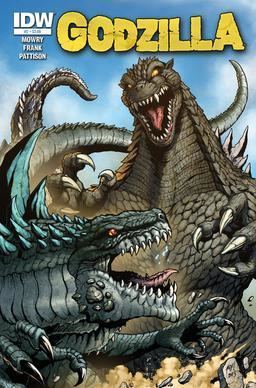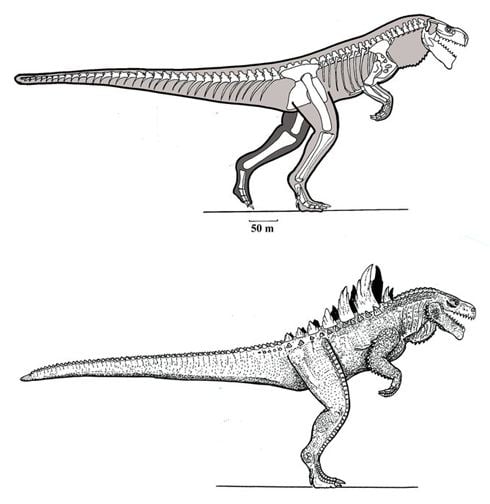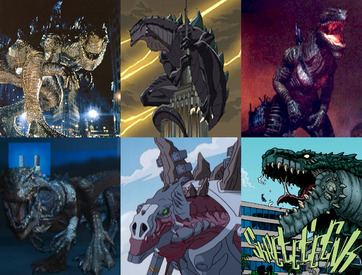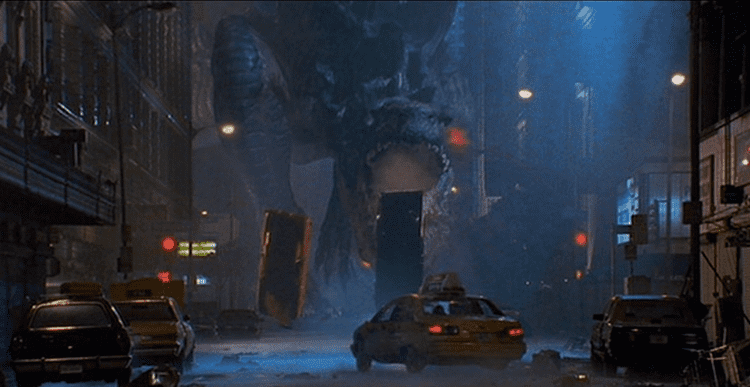Portrayed by Kurt Carley Species Irradiated iguana First appearance Godzilla (1998) | Aliases Godzilla
Godzilla-USA Played by Kurt Carley Movie Godzilla | |
 | ||
Created by Dean Devlin, Roland Emmerich and Patrick Tatopoulos Last appearance Godzilla: Final Wars (2004) Creators Roland Emmerich, Dean Devlin Similar Godzilla, Mothra, King Ghidorah, Mechagodzilla, Gigan | ||
Zilla (ジラ, Jira) is a film monster that first appeared as the title character in TriStar Pictures' 1998 film Godzilla. It was initially created as a reimagining of Godzilla; however after 2004, Toho (the Godzilla IP owners) began trademarking future incarnations of TriStar's Godzilla as "Zilla", with only the incarnations from the 1998 film and Godzilla: The Series retaining the Godzilla copyright and trademark.
Contents

Name

Initially, during production of Godzilla: Final Wars, director Ryuhei Kitamura asked producer Shōgo Tomiyama whether or not they were allowed to include TriStar's Godzilla in the film, whereupon Tomiyama checked Toho's contract with Sony and saw they were allowed to use it. However, they titled their new incarnation of TriStar's Godzilla as "Zilla" for its appearance in Godzilla: Final Wars. This decision was made because they also felt that Emmerich's film had taken the "God" out of "Godzilla" by portraying the character as a mere animal. The name "Zilla" was chosen for the character by Tomiyama as a satirical take on counterfeit Godzilla products that use "Zilla" as a suffix.

The "Zilla" name has since been trademarked by Toho and this name change has been reflected in subsequent official products featuring the character since its official retcon in 2004, though "Godzilla" continues to be used as a title on products that predate the name change, such as any re-release of the 1998 film or Godzilla: The Series. Matt Frank (co-writer and illustrator of Godzilla: Rulers of Earth) further clarified the name change, stating, "Toho makes zero distinction between "Zilla" and "Godzilla 1998" with the exception of title alone. Ever since 2004, Toho's official stance has been that any future incarnations of the character be referred to hereafter as 'Zilla'." Keith Aiken (author of SciFi Japan) also clarified that "Zilla is a variation of the 1998 Godzilla" but stressed that only the incarnations from the 1998 film and the animated series retain the Godzilla copyright and trademark.
Development

During the production of the 1998 film, special effects artist Patrick Tatopoulos was contacted by director Roland Emmerich and asked to create a new design for the Godzilla character. According to Tatopoulos, the only specific instructions Emmerich gave him was that it should be able to run incredibly fast.
Godzilla was originally conceived by special effects director Eiji Tsubaraya, special effects designers Akira Wantanabe and Teizo Toshimitsu and director Tomoyuki Tanaka as a robust, erect-standing, plantigrade reptilian sea monster, played by an actor in a rubber-latex full-body suit. Based on the instructions Emmerich gave him, Tatopoulos reimagined it as a lean, digitigrade bipedal iguana that stood with its back and tail parallel to the ground, rendered via computer animation. The monster's distinctive facial features include a prominent lantern jaw, inspired by the fictional tiger Shere Khan from Disney's animated adaptation of The Jungle Book.
TriStar's Godzilla color scheme was designed to reflect and blend in with the urban environment. At one point, it was planned to use motion capture to create the movements of the computer-generated monster, but it ended up looking too much like a man in a suit. The Baby Godzilla scenes utilized a combination of CGI and purpose built costumes donned by actors. Kurt Carley portrayed the suitmation sequences for the adult Godzilla in the 1998 film.
Upon pending approval for the design, at the time, Shōgo Tomiyama commented on the new look, saying "It was so different we realized we couldn't make small adjustments. That left the major question of whether to approve it or not." Though TriStar's Godzilla was referred to by the film's characters as a "he", Patrick Tatopoulos stated on a DVD audio commentary that the effects crew sculpted female genitalia into the CG model of the creature.
In the 1998 film and animated series, TriStar's Godzilla is portrayed as a territorial, piscivorous, 190 feet (58 m) tall mutated lizard. Atypical of Toho's giant monster characters, TriStar's Godzilla is not immune to conventional weaponry, and instead relies on its cunning and athleticism to outflank its enemies. It can travel long distances over land and sea, burrow underground and reproduce via parthenogenesis, and is able to lay over 200 eggs, unlike its offspring in the animated series which was unable to reproduce. It possesses an ignitable radioactive breath weapon called "Power Breath", although its offspring could breathe a green atomic Power Breath in the animated series (where also the parent, resurrected as a cyborg called Cyber-Godzilla, possessed a blue version), in which it was pitted against a rogues gallery of original monsters, after the producers were unable to secure the rights to adapt Toho's classic monsters. It was also featured in advertisements alongside the Taco Bell chihuahua.
TriStar's Godzilla was featured in the 2004 Toho film Godzilla: Final Wars as "Zilla"; this name would continue to be used and trademarked for later incarnations. A 3D scan of the Trendmasters "Ultimate Godzilla" toy was used as reference for Zilla. In the film, Zilla engages Toho's Godzilla in a battle intended "to show which Godzilla is stronger". Zilla would fight Godzilla again, in a slightly longer battle, in the 2013 comic series by IDW Publishing titled Godzilla: Rulers of Earth.
Reception
The design and characterization of TriStar's Godzilla was negatively received. Film critic Richard Pusateri of G-Fan Magazine coined the acronym GINO ("Godzilla In Name Only") to distinguish it from the original Godzilla by Toho while some fans referred to it as the "American Godzilla". The major points of criticism were centered around the character's radical departure from the traditional Godzilla design, how it was portrayed fleeing from the military, how it didn't breathe traditional nuclear fire, how it laid eggs, and was killed by missiles during the film's climax. These sentiments were echoed by veteran Godzilla suit actors Haruo Nakajima and Kenpachiro Satsuma, and by Shusuke Kaneko, director of the 90s Gamera films. Nakajima ridiculed the character design, stating: "Its face looks like an iguana and its body and limbs look like a frog". Satsuma walked out of the film, saying "it's not Godzilla, it doesn't have his spirit". Kaneko opined "[Americans] seem unable to accept a creature that cannot be put down by their arms", and later alluded to the character in his film Godzilla, Mothra and King Ghidorah: Giant Monsters All-Out Attack as a monster that Americans mistook for Godzilla.
The animated version of the character was more positively received than its live-action predecessor, due to being closer in line with the spirit of Toho's Godzilla, possessing the ability to breathe atomic fire, battle monsters, and withstand attacks. However, the negative response to both Emmerich's Godzilla as well as the Disney remake of Mighty Joe Young released that same year, had caused giant monster movies to fall out of vogue for several years after, with films such as Peter Jackson's King Kong remake being postponed until 2005. Poor merchandise sales for the film led to a cancellation of a toyline based on Godzilla: The Series, and resulted in significant financial losses for toy manufacturer Trendmasters, which went out of business soon after.
Appearances
The character has only made two feature film appearances, in the 1998 film Godzilla (as Godzilla) and in the 2004 film Godzilla: Final Wars (as Zilla) but was vaguely referenced to in the 2001 film Godzilla, Mothra and King Ghidorah: Giant Monsters All-Out Attack. For the production of the video games Godzilla: Save the Earth and Godzilla: Unleashed, developer Simon Strange decided not to include Zilla due to the character's unpopularity among fans. Ironically, Strange received criticism from fans for not including Zilla in the latter game.
